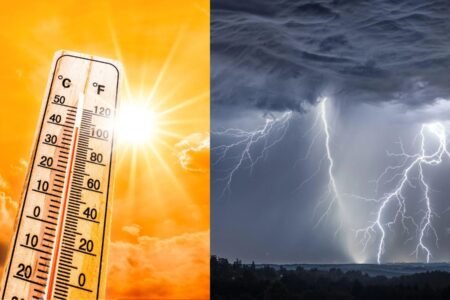In many parts of India, May has signified the peak of summer with extreme heat, dry weather, and anticipation for the soon-to-come monsoon in June. This year, however, dramatic events in May have become a peculiarly ubiquitous occurrence; across parts of northern and central India, there were episodes of heavy rainfall and thunderstorms, with resultant damage to crops and flooding on road and street surfaces and disruptive events in people’s livelihoods. Such events might read, feel, and sound like freak events; however, they appear to be increasingly common. They reflect climate change effects on already precarious environments and communities, and the disproportionate impacts this has on vulnerable individuals and communities. In recent days, cases of erratic weather patterns have been on the rise in India. Farmers expect to be protecting their rabi harvest with rains and thunderstorms this May, when preparing to sow the next season. Instead, fields in a host of states, from Uttar Pradesh mangoes and Madhya Pradesh wheat to a host of vegetables in Maharashtra, faced damage from hail and flooding. These weather anomalies are not outliers, but rather are consistent with a larger emergence of erratic climate behaviours globally, indicative of the localized consequences of global warming. Climate scientists are pointing out that the impact of rising global temperatures particularly disrupts global weather cycles. With the subtle monsoons of the Indian subcontinent, warming oceans, and shifting jet streams, rainfall fronts can appear earlier or later than expected and in extremes more intense than the systems can manage. These emergent storms and weather events are more than mere meteorological aberrations; they are indicators of a climate crisis that worsens each year. While the climate crisis is universal, it does not hit everyone the same. In India, it disproportionately weighs on the poor, smallholder farmers, especially daily wage earners, and informal workers. For them, unseasonal rains are not merely an inconvenience; they are life-threatening events.The very communities that emit the least to the global total, who lead low-carbon lives out of necessity, rather than preference, suffer most from its impact. This is what makes climate change not simply an environmental crisis, but a staggering issue of social and economic injustice. India has instituted multiple schemes to assist the climate-affected population, ranging from the Pradhan Mantri Fasal Bima Yojana for crop insurance to the Mahatma Gandhi National Rural Employment Guarantee Act (MGNREGA) for employment. However, there are gaps in coverage, uneven implementation, and delays are frequent. These nets are often inadequate in the face of furiously changing climate conditions. For instance, even when there is insurance access, small-scale farmers have a difficult time navigating the claim processes, and payouts do not capture the holistic losses. The informal workforce, who form over 90% of India’s working populace, is virtually devoid of any income protection due to weather extremes.On top of that, urban infrastructure continues to be poorly designed for unplanned heavy storms. The combination of lacking drainage systems, flimsy houses, and poorly controlled expansion results in cities facing catastrophic challenges even with moderate unseasonal rainfall. Addressing the unseasonal rainfall impacts is more than providing relief; it requires deep restructuring of climate resilience strategies around justice and equity. This involves: Developing more accurate forecasting models and quicker compensation mechanisms to better assist farmers, alongside investing in climate-resilient crops. Safeguarding informal and migrant workers, allowing uninterrupted access to income in the event of climate disruption, is also crucial. Focusing on improving urban slum areas and incorporating flood-proof infrastructure must be done to strengthen overall urban resilience. Incorporating climate-related plans developed by grassroots movements and indigenous people’s communities recognizes local knowledge. In every instance at hand, understanding that climate change is an ongoing challenge, rather than something to plan for the future, is crucial. Impacted people should not feel left behind while dealing with untackled challenging climate priorities. While May should be the month for the summer season in India, it now has a place on the calendar reserved for unseasonal rains and heavy downpours. Each unseasonal rain comes as a reminder that climate change is not just a concern for the future, but rather something affecting human life in real time. Through summer, the rivers on the subcontinent see blazing heat, and during monsoons, all the blessings of water are poured on them. Keep reading foramz
CONNECTING THOUGHTS

